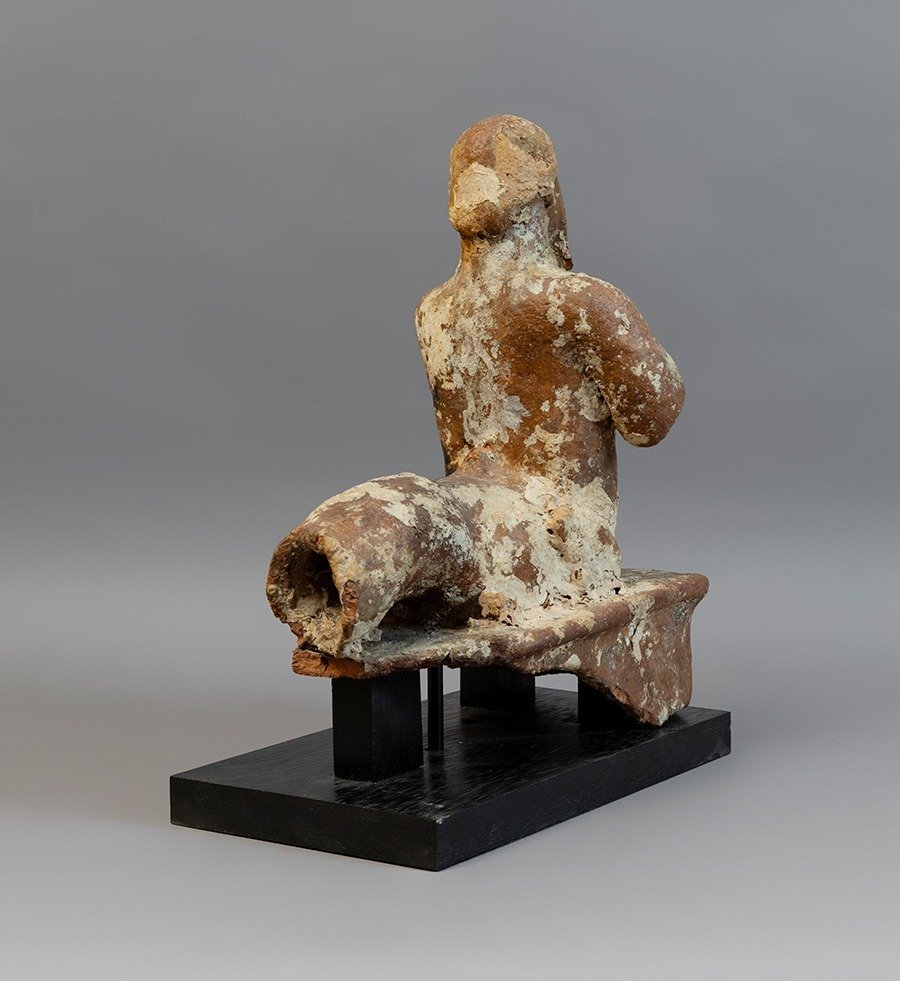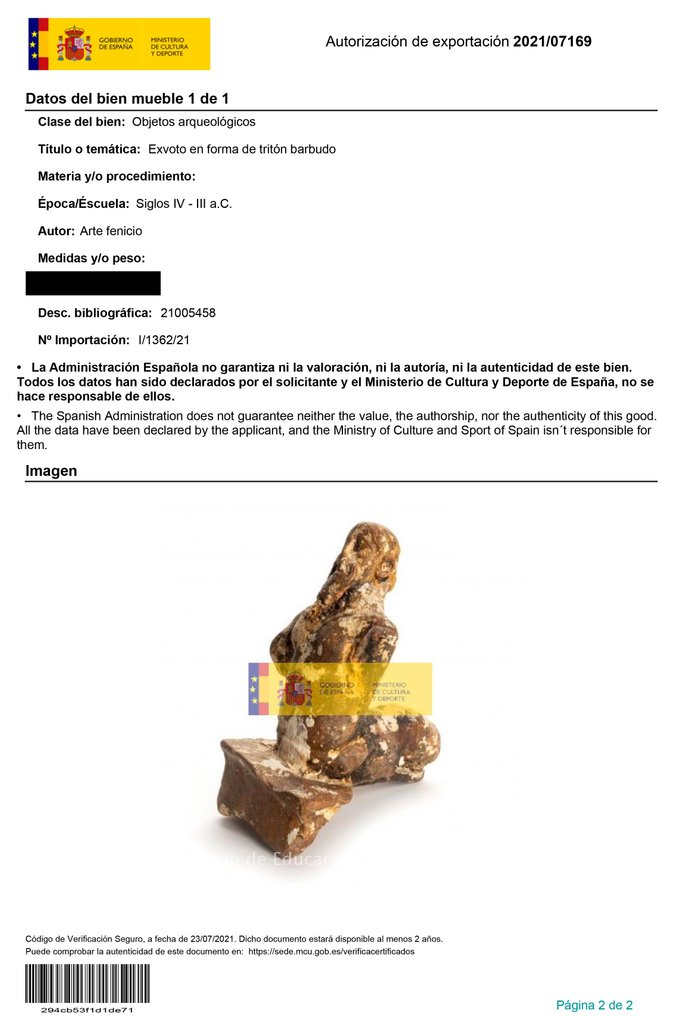merci, jolie bijou.
Katso käännösFoinikialainen Terrakotta Ex-Voto tai Idol, joka kuvaa Tritonia. 6-4-luvulla eKr. 32 cm Korkeus. Vanha alkuperä. Espanjan
Nro. 89257455






Important figure of an Ex-Voto or Idol depicting a Triton.
Phoenician, c. 6th - 4th century B.C.
32 cm H and 27 cm L. (without stand) 36 cm H with stand.
- STAND DISPLAY INCLUDED -
PROVENANCE: Maurice Druon Collection, Paris 1918 - 2009. Druon was a French writer and academic, Minister of Culture of France between 1973 and 1974.
CONDITION: Good state, see photos, unrestored.
DESCRIPCTION:
It is representing a Hybrid creature, the upper half being a man's body and lower half is a fish's body, specifically the tail.
It is presented on a base made in the form of an altar. The human torso is naked, with fine features such as the chest and the navel. The face has a serene expression with large almond shaped eyes highlighted by eyelids that are marked with a thick line, this being a Phoenician interpretation that is of clear Greek Archaïc inspiration.
At the height of the chin, there is a false beard, reminiscent of that used by the Egyptian pharaohs as a sign of power. The hair is worked in a smooth way, delimited in all its contour by a line of geometric design that frames the form of the man's head, this in turn links with the classic Greek tradition. In this way we can see how it is a piece that eclectically combines influences from styles such as Greek or Egyptian, the result of the Phoenicians' contacts with these cultures.
With respect to its iconography, it could be Yam, the god of the sea in the Canaanite pantheon. Yam is a deity of the sea and his palace is in the abyss associated with the depths. He represents the primordial chaos, the power of the sea, uncontainable and furious; he is seen as the god of dominant storms and the disasters they cause, and he was an important deity for the maritime Phoenicians.
This figure belongs to a group of Phoenician terracottas that remained 2,500 years under the sea until the 1960s when a fortuitous discovery made it possible to find all the pieces. One of the hypotheses that are being considered is that the Phoenicians, faced with the siege that the city suffered by Alexander the Great, loaded their ships with these pieces in order to escape from the city with their most precious goods. However, a storm must have surprised them a few kilometres from the coast, causing the ship to sink and the terracotta boats it contained to sink.
The sea god Triton, of Greek origin, is depicted on this Phoenician votive offering with a stylised face framed by a beard that gives him an aristocratic bearing. The muscular torso curves at the level of the hips, growing to the back with a long tail. He probably originally could have been blowing a conch shell. It follows Greek precepts in terms of representation, with the torso of a man and the lower part of a fish. Legend has it that Triton lived with his parents, Poseidon and Amphitrite, in a golden palace at the bottom of the sea. He is often depicted with a conch shell that he blows like a trumpet. The Phoenician culture, and later the Romans, inherited this figure and reinterpreted its symbolism. Here, adopting the role of an ex-vota, he gives good fortune to sailors.
Notes:
The seller guarantees that he acquired this piece according to all national and international laws related to the ownership of cultural property. Provenance statement seen by Catawiki.
The piece includes authenticity certificate.
The piece includes Spanish Export License.
THE MINISTRY OF CULTURE FROM SPAIN ASKS ALL SELLERS FOR INVOICES OR OTHER DOCUMENTATION ABLE TO PROVE THE LEGALITY OF EACH ITEM BEFORE PROVIDING AN IMPORT OR EXPORT LICENSE.
Myyjän tarina
Important figure of an Ex-Voto or Idol depicting a Triton.
Phoenician, c. 6th - 4th century B.C.
32 cm H and 27 cm L. (without stand) 36 cm H with stand.
- STAND DISPLAY INCLUDED -
PROVENANCE: Maurice Druon Collection, Paris 1918 - 2009. Druon was a French writer and academic, Minister of Culture of France between 1973 and 1974.
CONDITION: Good state, see photos, unrestored.
DESCRIPCTION:
It is representing a Hybrid creature, the upper half being a man's body and lower half is a fish's body, specifically the tail.
It is presented on a base made in the form of an altar. The human torso is naked, with fine features such as the chest and the navel. The face has a serene expression with large almond shaped eyes highlighted by eyelids that are marked with a thick line, this being a Phoenician interpretation that is of clear Greek Archaïc inspiration.
At the height of the chin, there is a false beard, reminiscent of that used by the Egyptian pharaohs as a sign of power. The hair is worked in a smooth way, delimited in all its contour by a line of geometric design that frames the form of the man's head, this in turn links with the classic Greek tradition. In this way we can see how it is a piece that eclectically combines influences from styles such as Greek or Egyptian, the result of the Phoenicians' contacts with these cultures.
With respect to its iconography, it could be Yam, the god of the sea in the Canaanite pantheon. Yam is a deity of the sea and his palace is in the abyss associated with the depths. He represents the primordial chaos, the power of the sea, uncontainable and furious; he is seen as the god of dominant storms and the disasters they cause, and he was an important deity for the maritime Phoenicians.
This figure belongs to a group of Phoenician terracottas that remained 2,500 years under the sea until the 1960s when a fortuitous discovery made it possible to find all the pieces. One of the hypotheses that are being considered is that the Phoenicians, faced with the siege that the city suffered by Alexander the Great, loaded their ships with these pieces in order to escape from the city with their most precious goods. However, a storm must have surprised them a few kilometres from the coast, causing the ship to sink and the terracotta boats it contained to sink.
The sea god Triton, of Greek origin, is depicted on this Phoenician votive offering with a stylised face framed by a beard that gives him an aristocratic bearing. The muscular torso curves at the level of the hips, growing to the back with a long tail. He probably originally could have been blowing a conch shell. It follows Greek precepts in terms of representation, with the torso of a man and the lower part of a fish. Legend has it that Triton lived with his parents, Poseidon and Amphitrite, in a golden palace at the bottom of the sea. He is often depicted with a conch shell that he blows like a trumpet. The Phoenician culture, and later the Romans, inherited this figure and reinterpreted its symbolism. Here, adopting the role of an ex-vota, he gives good fortune to sailors.
Notes:
The seller guarantees that he acquired this piece according to all national and international laws related to the ownership of cultural property. Provenance statement seen by Catawiki.
The piece includes authenticity certificate.
The piece includes Spanish Export License.
THE MINISTRY OF CULTURE FROM SPAIN ASKS ALL SELLERS FOR INVOICES OR OTHER DOCUMENTATION ABLE TO PROVE THE LEGALITY OF EACH ITEM BEFORE PROVIDING AN IMPORT OR EXPORT LICENSE.
Myyjän tarina
- 824
- 9
- 1
Ik heb het goed en snel ontvangen. Het ziet er goed uit. Ben er blij mee.
Katso käännösGreat seller!!
Katso käännösBagot siempre rápido y fiable, muchas gracias
Katso käännösgreat scarab! very fast shipping! thank you very much!
Katso käännösTodo bien. Vendedor recomendado.
Katso käännösAbsolut vertrauenswürdiger Händler ! Und: ein ganz zauberhaftes Stück !
Katso käännösOttimo imballo particolare come da foto
Katso käännösTodo bien. Persona muy amable y atenta. Recomendado.
Katso käännösTodo bien. Vendedor muy amable y atento. Recomendado.
Katso käännösTodo bien. Persona muy amable y atenta. Vendedor recomendado.
Katso käännösTodo bien. Envío muy cuidado, de auténtico profesional. Persona, además, muy amable y atenta. Vendedor recomendado.
Katso käännösa recommander envoi tres rapide est sécurisé embalage tres bien fait vraiment rien a dire plus que parfait
Katso käännösBeautiful objects! Extremely fast shipment! I can fully recommend this seller.
Katso käännöswonderful apis!very fast shipping!thanks a lot
Katso käännöspezzo bellissimo, e spedito a tempo record, venditore veloce onesto e preciso, consigliatissimo. Grazie
Katso käännösAlways a great pleasure !
Katso käännösEnvíos siempre con cuidado
Katso käännösBuen vendedor
Katso käännösObjekte wie abgebildet, das Gefäss sogar noch schöner / unkomplizierter Versand und sehr gut verpackt. Perfekte Transaktion!!
Katso käännössuperb, as usual
Katso käännösGreat object, fast delivery
Katso käännösProfessional seller. Object received s described. Fair price
Katso käännösTodo ok
Katso käännösWell packed, fast delivery. Arrived safely, in good condition. Thank you!
Katso käännösVastuuvapauslauseke
Myyjä vakuuttaa ja voi todistaa, että esine on hankittu laillisesti. Catawiki on informoinut myyjää asiakirjoista, jotka hänen täytyy hankkia maansa lakien ja säännösten velvoittamana. Myyjä vakuuttaa olevansa oikeutettu esineen myymiseen/maasta vientiin. Myyjä antaa ostajalle kaikki esineen saatavilla olevat provenienssitiedot. Myyjä vakuuttaa omaavansa/hankkivansa kaikki tarvittavat luvat. Myyjä ilmoittaa ostajalle pikimmiten mahdollisista lupien viivästyksistä.
Myyjä vakuuttaa ja voi todistaa, että esine on hankittu laillisesti. Catawiki on informoinut myyjää asiakirjoista, jotka hänen täytyy hankkia maansa lakien ja säännösten velvoittamana. Myyjä vakuuttaa olevansa oikeutettu esineen myymiseen/maasta vientiin. Myyjä antaa ostajalle kaikki esineen saatavilla olevat provenienssitiedot. Myyjä vakuuttaa omaavansa/hankkivansa kaikki tarvittavat luvat. Myyjä ilmoittaa ostajalle pikimmiten mahdollisista lupien viivästyksistä.









